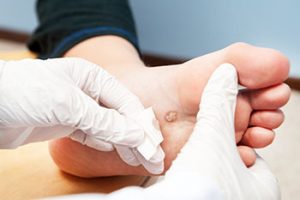Skin Conditions

Although podiatrists primarily focus on the care of the foot and ankle, there are several common dermatology related issues that can be treated in our office. These include but are not limited to dermatitis, athlete’s foot, melanoma, and warts.
Dermatitis –
Dermatitis is defined as an irritation of the skin. It is a common condition that has a variety of causes and can be in many forms. Dermatitis generally involves the skin to be dry, itchy, and possibly reddened. It can also cause the skin to blister or harden. Each type of dermatitis will look different and often tends to occur on a different part of the body.
What causes dermatitis?
Eczema is the type of dermatitis, which is related to dry skin, an immune system dysfunction, skin infection, or a combination of these. Contact dermatitis is a form of dermatitis which results from contact with something that irritates the skin and causes an allergic reaction. Irritants can include but are not limited to plants, perfumes, creams, lotions, and jewelry containing nickel.
What is the best treatment for dermatitis?
Treatments for dermatitis may include the use of moisturizer or topical steroids. As each form of dermatitis varies from the next, treatment is case by case.
Athlete’s Foot –
What is Athlete’s Foot?
Athlete’s Foot, medically known as tinea pedis, is a fungal infection which occurs most commonly in between the toes but can also affect other areas of the foot. Fungus grows in damp environments, which are commonly found inside your shoe, around bodies of water (pool, lakes, ocean), and the shower. Athlete’s feet specifically occur in people whose feet have become very sweaty while wearing tightfitting shoes, most commonly athletes.
How to treat Athlete’s Foot?
Treatments for tinea pedis include over the counter medication as well as prescriptions for topical anti-fungal medication (for severe cases), as well as encouragement to keep feet dry.
Melanomas of the Foot –
What is a melanoma?
Melanoma is a cancer that begins in the cells of the skin that produce pigmentation (coloration). It can occur on your skin, but also be present in your fingernail or toenail bed. Most cases of melanoma include too much exposure to ultraviolent rays from the sun or tanning beds but can also come from exposure to radiation.
What are symptoms of a melanoma?
The ABCDs of melanomas are the signs to look for on your skin.
- Asymmetry (one half of the spot is different in shape than the other half)
- Border (border is irregular)
- Color (mix of colors or hues are present)
- Diameter (Melanoma grows, whereas moles will remain small).
How to treat a melanoma?
Treatment begins with examining the area of concern and then taking a biopsy. If the biopsy determines the area to be cancerous, your podiatrist will recommend the best courses of treatment.
Plantar Warts –
What is a plantar wart?
Warts are caused by a viral infection of the skin. This occurs as a result of direct contact with the virus. When they occur on the bottom of the foot, these lesions are known as plantar warts. Warts cannot live in any tissue except the skin. Moist, sweaty feet can be a predisposition of the virus.
How to diagnose a plantar wart?
Warts have an appearance of thick, scaly skin and often resemble a plantar callus. However, if squeezing of a lesion results in pain that is the differential between a plantar wart and a callus.
What is the treatment for a plantar wart?
Professional treatment of a wart may include but not limited to: burning the wart with topical acids, freezing with liquid nitrogen, laser surgery, or cutting them out. As no method is a hundred percent effective, there is a chance that the wart may come back. Surgical excision of the wart has the highest success rate of treatment. Topical acids can also be useful means of treating warts.
